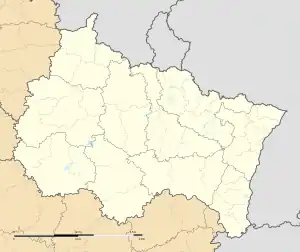Semide
Semide is a commune in the Ardennes department in the Grand Est region in northern of France.
Semide | |
|---|---|
 The church in Semide | |
 Coat of arms | |
Location of Semide | |
 Semide  Semide | |
| Coordinates: 49°20′30″N 4°35′01″E | |
| Country | France |
| Region | Grand Est |
| Department | Ardennes |
| Arrondissement | Vouziers |
| Canton | Attigny |
| Intercommunality | Argonne Ardennaise |
| Government | |
| • Mayor (2020–2026) | Hubert Oudin[1] |
| Area 1 | 37.04 km2 (14.30 sq mi) |
| Population | 177 |
| • Density | 4.8/km2 (12/sq mi) |
| Time zone | UTC+01:00 (CET) |
| • Summer (DST) | UTC+02:00 (CEST) |
| INSEE/Postal code | 08410 /08400 |
| Elevation | 110–204 m (361–669 ft) (avg. 149 m or 489 ft) |
| 1 French Land Register data, which excludes lakes, ponds, glaciers > 1 km2 (0.386 sq mi or 247 acres) and river estuaries. | |
It is located 200 km (120 mi) northeast of Paris, 40 km (25 mi) of Reims.
History
Semide has not always been what it is today. Formerly, the chalky soil gave bad harvest. This poor land, where resinous had been plant under the Second Empire provided to the sheep kine sparse grass. In the 1960s, Semide underwent a change which has modified its economy, its way of life and the landscape. Mecanisation, motorisation, clearing, fertilizer utilization and regrouping of lands mark out the intensive farming beginning dominates by cereals.
Population
The inhabitants are called Semidas.
| Year | Pop. | ±% |
|---|---|---|
| 1962 | 314 | — |
| 1968 | 293 | −6.7% |
| 1975 | 251 | −14.3% |
| 1982 | 264 | +5.2% |
| 1990 | 258 | −2.3% |
| 1999 | 245 | −5.0% |
| 2008 | 213 | −13.1% |
Sights
- St-Pierre St-Paul Church from the twelfth century.
- Big Bertha : Vestige of an installation of a Langer Max (officially called 38 cm SKL/45), wrongly called by usage Big Bertha.
- National graveyard from the First World War.
Economy
Semide main's activity is farming, predominantly cereal and sugar beet production.
See also
References
- "Répertoire national des élus: les maires". data.gouv.fr, Plateforme ouverte des données publiques françaises (in French). 9 August 2021.
- "Populations légales 2020". The National Institute of Statistics and Economic Studies. 29 December 2022.
This article is issued from Wikipedia. The text is licensed under Creative Commons - Attribution - Sharealike. Additional terms may apply for the media files.